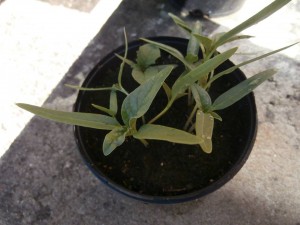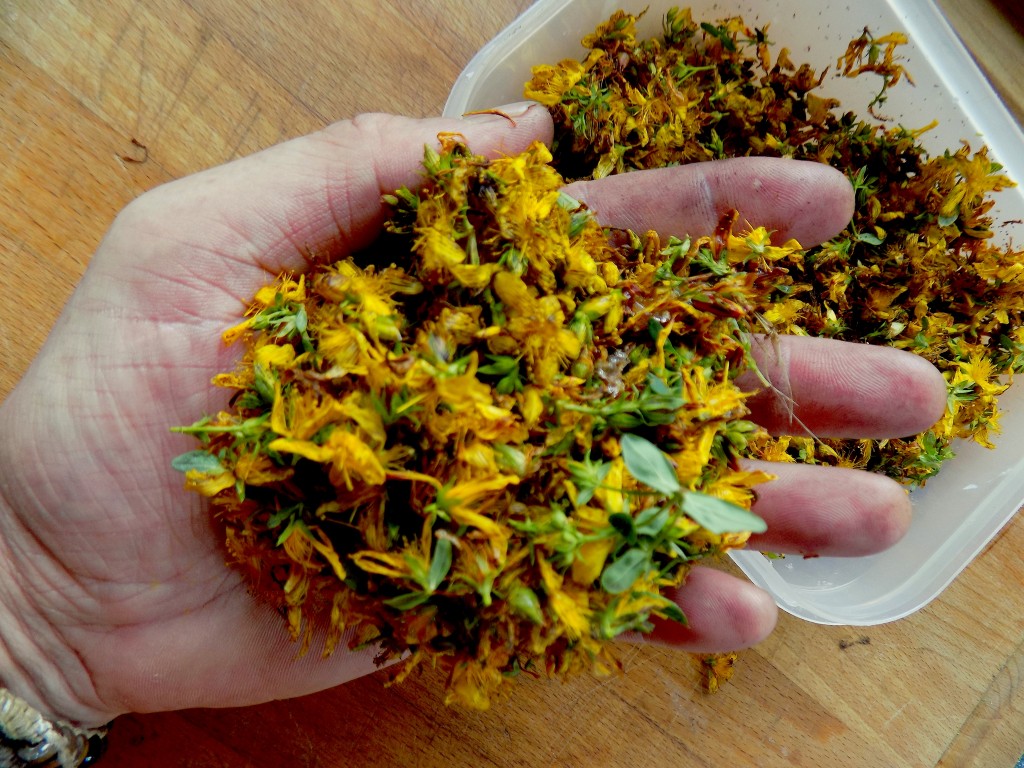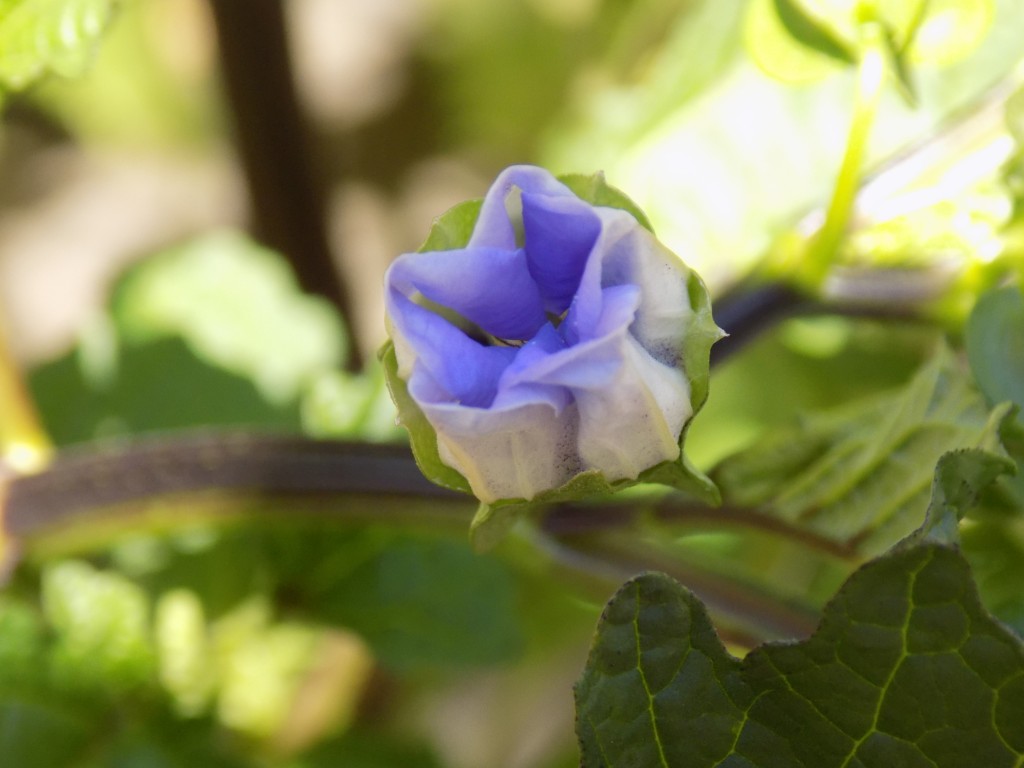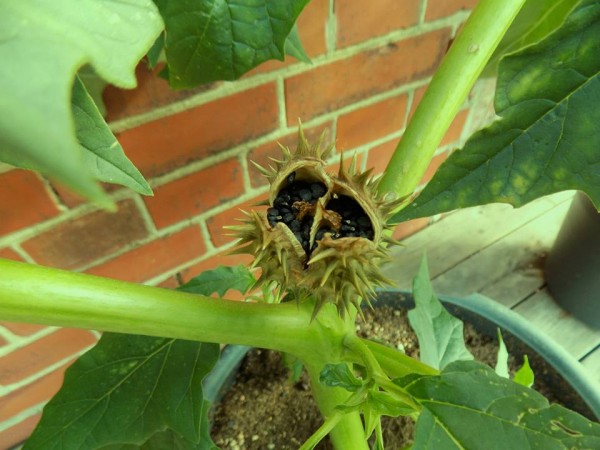A beautiful Zuni Indian legend tells of the divine origin of Aneglakya, Datura anoxia, their most sacred plant:
“In the olden time a boy and a girl, brother and sister (The boys name was A´neglakya and the girls name A´neglakyatsi´tea), lived in the interior of the earth, but they often came to the outer world and walked about a great deal, observing closely everything they saw and heard and repeating all to their mother. This constant talking did not please the Divine Ones (twin sons of the Sun Father). On meeting the boy and the girl the Divine Ones asked, “how are you?”, and the brother and sister answered, “we are happy”. They told the Divine ones how they could make one sleep and see ghosts, and how they could make one walk about a little and see one who had committed theft. After this meeting the Divine Ones concluded that the boy and the girl knew too much and that they should be banished for all time from this world; so the Divine Ones caused the brother and sister to disappear into the earth forever. Flowers sprang up at the spot where the two descended – flowers exactly like those that they wore on each side of their heads when visiting the earth. The Divine Ones called the plant a´neglakya after the boys name.”
“Plants of the Gods”, p. 106
Schulters, Hofman, Rätsch
(Healing Arts Press, 1992)
And the secret garden bloomed and bloomed and
every morning revealed new miracles.
Frances Hodgson Burnett (1849 – 1924)
“The Secret Garden”
 Don Juan claimed its power was not unlike that of a woman saying: “She (Datura) is as powerful as the best of allies, but there is something I personally don’t like about her. She distorts men. She gives them a taste of power too soon without fortifying their hearts and makes them domineering and unpredictable. She makes them weak in the middle of their great power.”
Don Juan claimed its power was not unlike that of a woman saying: “She (Datura) is as powerful as the best of allies, but there is something I personally don’t like about her. She distorts men. She gives them a taste of power too soon without fortifying their hearts and makes them domineering and unpredictable. She makes them weak in the middle of their great power.”
“You see. The devil’s weed is like that. She sneaks up on you like a woman. You are not even aware of it. All you care about is that she makes you feel good and powerful: the muscles swelling with vigor, the fists itching, the soles of the feet burning to run somebody down. When a man knows her he really becomes full of cravings. My benefactor used to say that the devil’s weed keeps men who want power, and gets rid of those who can’t handle it. But power was more common then; it was sought more avidly. My benefactor was a powerful man, and according to what he told me, his benefactor, in turn, was even more given to the pursuit of power. But in those days there was good reason to be powerful.”
“I don’t like its power! There is no use for it anymore. In other times, like those my benefactor told me about, there was reason to seek power. Men performed phenomenal deeds, were admired for their strength and feared and respected for their knowledge. My benefactor told me stories of truly phenomenal deeds that were performed long, long ago. But now we, the Indians, do not seek that power anymore.”
Carlos Castaneda (1925 – 1998)
“The Teachings of Don Juan”
“The dreaming body is known by different names,” he said after a long pause. “The name I like the best is, the other. That term belongs to the old seers, together with the mood. I don’t particularly care for their mood, but I have to admit that I like their term The other. It’s mysterious and forbidden. Just like the old seers, it gives me the feeling of darkness, of shadows. The old seers said that the other always comes shrouded in wind.”
Over the years don Juan and other members of his party had tried to make me aware that we can be in two places at once, that we can experience a sort of perceptual dualism. As don Juan spoke, I began to remember something so deeply forgotten that at first it was as if I had only heard about it. Then, step by step, I realized that I had lived that experience myself.
Carlos Castaneda (1925 – 1998)
“The fire from within”
 He explained that what he called the key to everything was the firsthand knowledge that the earth is a sentient being and as such can give warriors a tremendous boost; it is an impulse that comes from the awareness of the earth itself at the instant in which the emanations inside warriors’ cocoons are aligned with the appropriate emanations inside the earth’s cocoon. Since both the earth and man are sentient beings, their emanations coincide, or rather, the earth has all the emanations present in man and all the emanations that are present in all sentient beings, organic and inorganic for that matter. When a moment of alignment takes place, sentient beings use that alignment in a limited way and perceive their world. Warriors can use that alignment either to perceive, like everyone else, or as a boost that allows them to enter unimaginable worlds.
He explained that what he called the key to everything was the firsthand knowledge that the earth is a sentient being and as such can give warriors a tremendous boost; it is an impulse that comes from the awareness of the earth itself at the instant in which the emanations inside warriors’ cocoons are aligned with the appropriate emanations inside the earth’s cocoon. Since both the earth and man are sentient beings, their emanations coincide, or rather, the earth has all the emanations present in man and all the emanations that are present in all sentient beings, organic and inorganic for that matter. When a moment of alignment takes place, sentient beings use that alignment in a limited way and perceive their world. Warriors can use that alignment either to perceive, like everyone else, or as a boost that allows them to enter unimaginable worlds.
Carlos Castaneda (1925 – 1998)
“The Fire from Within”
 Each person is at each moment capable of remembering all that has ever happened to him and of perceiving everything that is happening everywhere in the universe. The function of the brain and nervous system is to protect us from being overwhelmed and confused by this mass of largely useless and irrelevant knowledge, by shutting out most of what we should otherwise perceive or remember at any moment, and leaving only that very small and special selection which is likely to be practically useful.
Each person is at each moment capable of remembering all that has ever happened to him and of perceiving everything that is happening everywhere in the universe. The function of the brain and nervous system is to protect us from being overwhelmed and confused by this mass of largely useless and irrelevant knowledge, by shutting out most of what we should otherwise perceive or remember at any moment, and leaving only that very small and special selection which is likely to be practically useful.
Aldous Huxley (1894 – 1963)
“The Doors of Perception”
The Doors of Perception is a short book by Aldous Huxley, first published in 1954, detailing his experiences when taking mescaline. The book takes the form of Huxley’s recollection of a mescaline trip that took place over the course of an afternoon, and takes its title from a phrase in William Blake’s 1793 poem The Marriage of Heaven and Hell. Huxley recalls the insights he experienced, which range from the “purely aesthetic” to “sacramental vision”. He also incorporates later reflections on the experience and its meaning for art and religion.
 There are lots of things a warrior can do at a certain time which
There are lots of things a warrior can do at a certain time which
he couldn’t do years before. Those things themselves did not
change; what changed was his idea of himself.
Carlos Castaneda (1925 – 1998)
“Tales of Power”
 “I was in the Plant Market on the Lord’s day, and heard behind me a great voice, as of a trumpet. And I saw the seven angels which stood before the gardeners; and to them were given seven trumpets. And the seven salesmen which had the seven trumpets prepared themselves to sound. After this I looked, and, behold, a door was opened in the greenhouse, and the first voice which I heard was as it were of a trumpet talking with me; which said, Come up hither, and I will shew thee things which must be hereafter. Then I bought it and took it home.”
“I was in the Plant Market on the Lord’s day, and heard behind me a great voice, as of a trumpet. And I saw the seven angels which stood before the gardeners; and to them were given seven trumpets. And the seven salesmen which had the seven trumpets prepared themselves to sound. After this I looked, and, behold, a door was opened in the greenhouse, and the first voice which I heard was as it were of a trumpet talking with me; which said, Come up hither, and I will shew thee things which must be hereafter. Then I bought it and took it home.”
(Revelation 4:1)
 Echinacea species are native to North America and were used as traditional herbal remedies by the Great Plains Indian tribes. Later, settlers followed the Indians’ example and began using echinacea for medicinal purposes as well. However, use of echinacea fell out of favor with the discovery of antibiotics and due to the lack of scientific evidence supporting its use. But now, people are becoming interested in echinacea again because antibiotics don’t work as well as they used to against certain bacteria.
Echinacea species are native to North America and were used as traditional herbal remedies by the Great Plains Indian tribes. Later, settlers followed the Indians’ example and began using echinacea for medicinal purposes as well. However, use of echinacea fell out of favor with the discovery of antibiotics and due to the lack of scientific evidence supporting its use. But now, people are becoming interested in echinacea again because antibiotics don’t work as well as they used to against certain bacteria.
 Hypericum perforatum has a long service to humankind, except where it’s been a pesky weed. Appropriately dubbed by many as a magical plant, St. John’s Wort carries a rich history, full of cultural nuances and mystical legends. Dr. Jonathan Zuess, in his book, “The Natural Prozac Program,” eloquently captures the emotion and quintessence of St. John’s Wort in his opening statement: “In the crumbling pages of ancient texts on healing, hidden amongst the dusty basement shelves of a neglected Old World library, there are stories of a flower whose tears are magical…..”
Hypericum perforatum has a long service to humankind, except where it’s been a pesky weed. Appropriately dubbed by many as a magical plant, St. John’s Wort carries a rich history, full of cultural nuances and mystical legends. Dr. Jonathan Zuess, in his book, “The Natural Prozac Program,” eloquently captures the emotion and quintessence of St. John’s Wort in his opening statement: “In the crumbling pages of ancient texts on healing, hidden amongst the dusty basement shelves of a neglected Old World library, there are stories of a flower whose tears are magical…..”
Paracelcus, suggested that St. John’s Wort flowers should be picked at sunrise in order to capture the active constituents. The bright, ray-like petals release their precious red liquid most efficiently when soaked in olive oil and left out in the sun for several days.This produces a beautiful, thick, red liquid which can then be applied externally on wounds, sprains, bruises and varicose veins. This oil was commonly referred to as the “blood of Christ”.
The ancient belief that St. John’s Wort conferred protection against evil spirits may have risen in part due to its use by traditional healers as a treatment for “melancholia” or what was known at that time as “troubled spirits.” It was assumed that when the overall disposition or mood of a person was downcast, sad or unsettled, this was the work of evil forces or demons.
St. John’s Wort was not initially used to treat what we now know as depression or anxiety but, fortunately, this hidden benefit was eventually realized while doctors and herbalists were treating wounds, burns and other injuries.
Writings during the 19th century continued to incorporate hypericum for the treatment of melancholia or as we know it today, depression. Some of these reported medicinal actions of St. John’s Wort have now been scientifically verified by double-blind studies, only to prove what the ancients knew all along.
 The Old Absinthe House is not a place. It is not bounded by four walls. It is headquarters to an army of philosophies. From this dim corner let me range, wafting thought through every air, salient against every problem of mankind: for it will always return like Noah’s dove to this ark, this strange little sanctuary of the Green Goddess which has been set down not upon Ararat, but by the banks of the “Father of Waters.”
The Old Absinthe House is not a place. It is not bounded by four walls. It is headquarters to an army of philosophies. From this dim corner let me range, wafting thought through every air, salient against every problem of mankind: for it will always return like Noah’s dove to this ark, this strange little sanctuary of the Green Goddess which has been set down not upon Ararat, but by the banks of the “Father of Waters.”
The word is from the Greek apsinthion. It means “undrinkable” or, according to some authorities, “undelightful.” In either case, strange paradox! No: for the wormwood draught itself were bitter beyond human endurance; it must be aromatized and mellowed with other herbs.
Then also there are added mint, anise, fennel and hyssop, all holy herbs familiar to all from the Treasury of Hebrew Scripture. And there is even the sacred marjoram which renders man both chaste and passionate; the tender green angelica stalks also infused in this most mystic of concoctions; for like the artemisia absinthium itself it is a plant of Diana, and gives the purity and lucidity, with a touch of the madness, of the Moon…
From “Absinthe: The Green Goddess”
By Aleister Crowley (1875 – 1947)
Aqua Vitae – The Water of Life
All pictures ©Writ-in-Water









